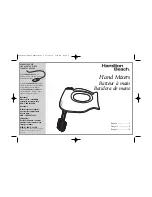
11
Owner’s Manual
Owner’
s Manual
4. Insert
These unbalanced 1/4" jacks are for connecting serial
effects processors such as compressors, equalizers,
de-essers, or filters. The insert point is after the gain
[3] control, but before the channel’s EQ [32], low cut
[33], fader [25] and mute [30] controls. Insert cables
must be wired thusly:
Tip = send (output to effects device)
Ring =
return (input from effects device)
Sleeve =
common ground
Even though channels 1–8 already have direct out [5]
jacks , insert jacks can also be used as channel direct
outputs; post-gain, pre-low cut, and pre-EQ. See the
connector section on page 29 showing three ways to use
insert cables.
5. Direct Out
Found only on channels 1–8, these balanced 1/4"
jacks deliver the signal from the very end of the channel
path; post-gain [3], post-EQ [32], post-low cut [33],
post-fader [25], and post-mute [30]. They are the key
player in “split monitoring,” making the 1604VLZ4
perfect for an 8-track studio.
Split Monitoring
With split monitoring, you use the first eight
channels for your sound sources: vocal mics,
drum mics, keyboard/synth outputs, guitar
effects outputs, that sort of thing. From there, the
channels manipulate the sound, but are not assigned to
the output section. Instead, they’re patched from the
channel’s direct out [5] jacks to the corresponding
multitrack input (direct out 1 to multitrack input 1, 2 to
2, 3 to 3, etc.). The signals will now be recorded or pass
directly through the multitrack, depending on each
track’s record-ready status.
tip
This plug connects to one of the
mixer’s Channel Insert jacks.
ring
tip
ring
sleeve
SEND to processor
RETURN from processor
(TRS plug)
multitrack
machine
sound sources
direct
outputs
group
outputs
1–8
9–16
The outputs of the multitrack are then patched
to the next eight line [2] inputs on the 1604VLZ4
(multitrack out 1 to line input 9, 2 to 10, 3 to 11, etc.).
These channels (9–16) will be assigned to the mixer’s
output section, delivering the signals to their ultimate
destination, which may be your mixdown 2-track, your
control room system, or your headphones.
But let’s not forget that the 1604VLZ4 is a 4-bus
mixer. These buses lead to the sub outs [8], and are
designed to accomplish the task of getting channels
to the multitrack without using the direct outputs.
For example, a channel is assigned to sub out 1.
Sub out 1’s output is patched to multitrack input 1.
From there, the multitrack output goes to the mixer’s
channel 9 line input, as we just discussed. (Hot tip:
To feed an 8-track deck with 4 sub outputs, simply use
Y-cords: sub out 1 feeds tracks 1 and 5, 2 feeds 2 and 6,
3 feeds 3 and 7, and 4 feeds 4 and 8. Tracks in record
mode will accept the signal, and tracks in safe mode
will ignore the signal.)
The advantages: You can assign any channel to any
track, without repatching. You can assign multiple chan-
nels to one track and control the overall level of that
subgroup. You can’t bounce tracks without this feature.
Perhaps the best method is to do both: Use the sub
outs to feed multichannel submixes (like a drum kit)
to some of the tracks, and the direct out jacks to feed
single-channel signals (like bass guitar) to the other
tracks.
The point is that you never listen directly to the
source channels (1–8). You listen to the monitor chan-
nels (9–16) and they’re listening to the multitrack that
is listening to the source channels. (Make sure to assign
the monitor channels 9-16 to the L/R mix, and not the
source channels 1-8.) The main advantage is that you
won’t be forced to constantly repatch your multitrack —
just set it up and forget it. You’ll also know for certain
that the signals are indeed getting to the multitrack,
since you’re constantly listening to it.
Another method of interfacing a multitrack is called
inline monitoring, and requires a dedicated mixing
console. Each of its channels is actually two channels:
one carrying the mic/line sound source and the other
carrying the multitrack output.
6. Aux Sends
These 1/4" jacks usually patch to the inputs of
a parallel effects devices or to the inputs of stage
monitor amps. For details see “Aux Talk” on page 23.
Effects: Serial Or Parallel?
You’ve heard us carelessly toss around the terms
“serial” and “parallel.” Here’s what we mean by them:
“Serial” means that the entire signal leaves the mixer
[insert (4) send], is routed through the effects device,
and returns to the mixer [insert return]. Examples:
compressor/limiters, graphic equalizers.
“Parallel” means that a portion of the signal in the
mixer is tapped off to the device (aux send), processed
and returned to the mixer (stereo return) to be mixed
with the original “dry” signal. This way, multiple
channels can all make use of the same effects device.
Examples: reverb, digital delay.
Dry Signal
Processed
Signal
Insert
Send
Insert
Return
Dry Signal(s)
Dry Signal(s)
Aux
Send
Aux
Return
Wet Signal
Channel Path
Mix
Stage
Output
Section
Processed
Signal
Signal Processor
(e.g., Compressor)
Signal Processor
(e.g., Reverb)
Dry Signal
Processed
Signal
Insert
Send
Insert
Return
Dry Signal(s)
Dry Signal(s)
Aux
Send
Aux
Return
Wet Signal
Channel Path
Mix
Stage
Output
Section
Processed
Signal
Signal Processor
(e.g., Compressor)
Signal Processor
(e.g., Reverb)
Dry Signal
Processed
Signal
Insert
Send
Insert
Return
Dry Signal(s)
Dry Signal(s)
Aux
Send
Aux
Return
Wet Signal
Channel Path
Mix
Stage
Output
Section
Processed
Signal
Signal Processor
(e.g., Compressor)
Signal Processor
(e.g., Reverb)












































